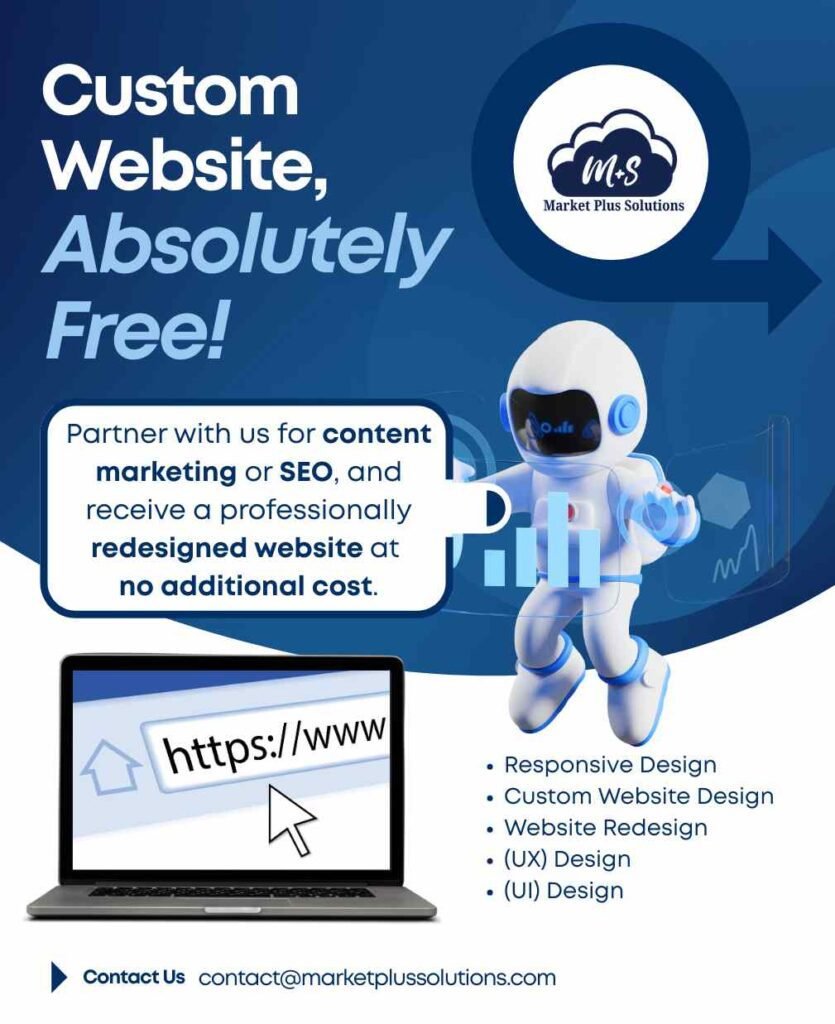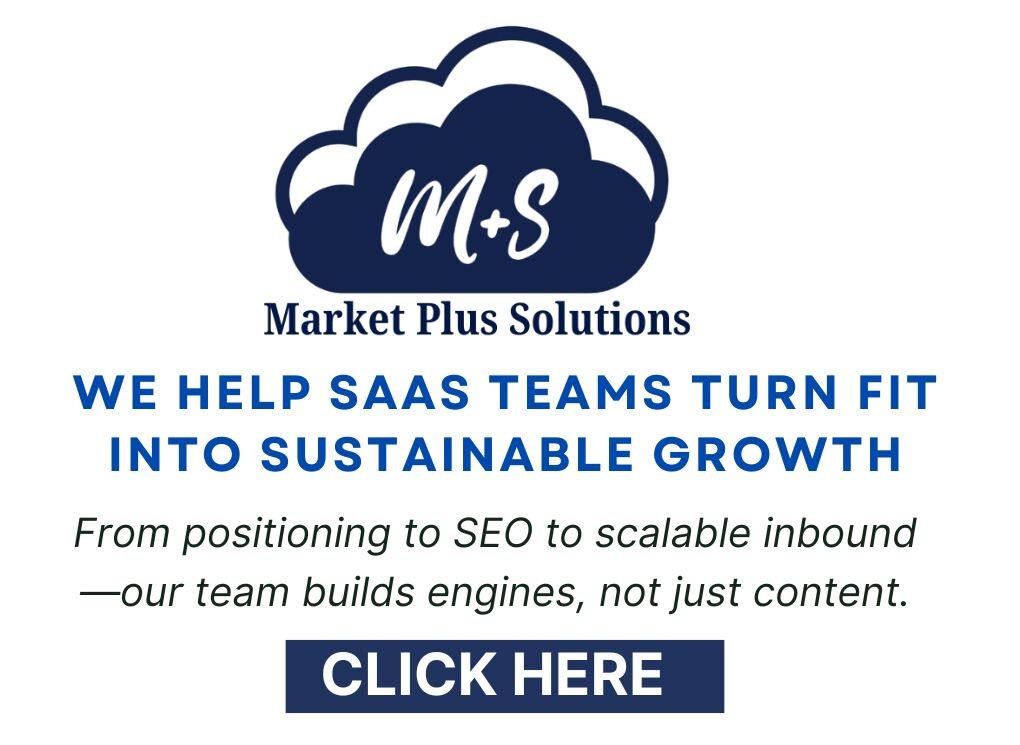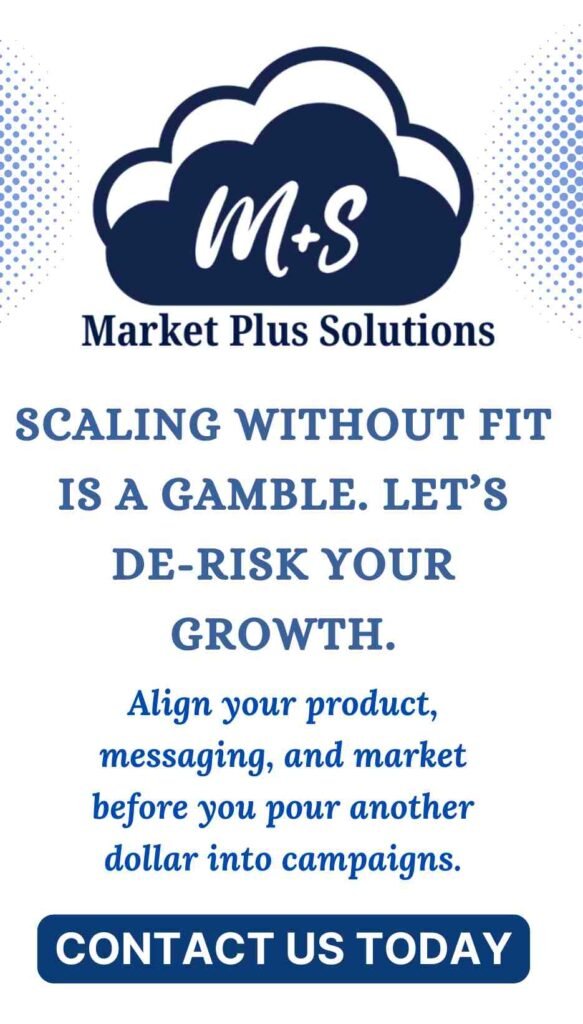The Silent Plateau: A Product-Market Fit SaaS Failure in Disguise
Hitting $30K or $50K MRR should feel like lift-off.
For most early-stage SaaS founders, it’s the signal they’ve reached product-market fit. But instead of accelerating, growth flattens — and a silent threat begins to emerge.
CAC keeps rising.
Retention weakens.
Expansion revenue stalls.
You’re inside the dreaded SaaS growth plateau, and the cause isn’t what most think. The funnel’s working, the team is shipping fast, and sales is doing the rounds. But the product? It’s misaligned — not with execution, but with the market.
You may be scaling a Product-Market Fit SaaS that never really had true fit to begin with.
This is more than a growth hiccup.
It’s a case of false product-market fit — and if you don’t catch it early, it kills retention, burns capital, and blocks expansion. Validating your SaaS product-market fit isn’t a milestone — it’s a survival checkpoint.
The Big Lie That Keeps Product-Market Fit SaaS Startups Stuck
You hit $40K MRR. A few recognizable logos sign on. Investor interest picks up.
On paper, it looks like traction. It feels like product-market fit.
But here’s where most SaaS founder mistakes begin: confusing early wins with real market pull.
What follows is a shift from listening to the market… to chasing vanity metrics. ARR becomes the north star. Feature requests from edge cases shape the roadmap. Cash gets funneled into paid acquisition instead of solving for SaaS churn and retention.
This is how teams fall into the most dangerous trap in early-stage SaaS: scaling without product-market fit.
It’s called false product-market fit, and it’s far more damaging than having no fit at all.
Why?
Because it offers enough surface-level validation to justify hiring, raising, expanding — all while the underlying signals are off.
You’re building momentum on assumptions. And eventually, that momentum hits a wall.
Real Product-Market Fit in SaaS doesn’t just show up as user activity. It manifests as undeniable pull.
- Customers rely on your product.
- They mention it unprompted.
- They bring colleagues in without nudging.
- Your inbound pipeline starts to outpace your outbound efforts.

If that’s not your reality, don’t scale.
Reassess your product-market fit framework, revisit your core use case, and focus on validating product-market fit with precision. Because every quarter you operate on false signals is a quarter of lost efficiency — and potentially irreversible churn.
7 Brutal Signs Your Product-Market Fit SaaS Is Built on Shaky Ground
This is where things get risky.
Again, you’ve built what users asked for and you’ve got some MRR, customer logos, even a few case studies. But something’s off. Because growth isn’t predictable. Users are quiet and churn is creeping up.
These aren’t just early-stage growing pains. They’re structural warning signs — and if you ignore them, you’ll end up scaling without product-market fit.
Let’s break it down. If you recognize more than two of these in your SaaS, you’re not scaling — you’re circling:
1. Churn creeps up, and nobody has a clear answer: Support tickets pile up. Onboarding feels inconsistent. Every new user uncovers a new edge case or friction point. This signals poor retention fundamentals — not just a support gap.
2. Retention is fragile and reactive: Lose one feature, lose the customer. Your roadmap becomes a race to keep users from leaving — not a path to long-term value. This isn’t growth — it’s survival mode.
3. Acquisition costs rise, while win rates fall: You’re pumping budget into paid campaigns, but the sales cycle is stretching out — and conversions are stalling. Classic symptom of a SaaS growth plateau driven by misfit.
4. Low engagement and zero referrals: Users sign in, but they’re not talking about your product. No virality. No product-led growth. No network effects. This is the absence of true market pull.
5. You’re chasing the wrong segments: Big logos, low retention. The customer profile looks good in a pitch deck but fails on expansion and LTV. Early-stage SaaS metrics here don’t lie — churned revenue tells the real story.
6. Sales and marketing are misaligned: Sales says leads are unqualified. Marketing says product isn’t sticky. When everyone’s working harder but results stay flat, it points to a deeper product-market misalignment.
7. More features, less clarity: Every roadmap meeting turns into a wishlist. But velocity doesn’t equal traction. You’re building more — but solving less.
These are not just surface-level issues — they’re clear indicators of false product-market fit.
When SaaS churn and retention start slipping, don’t double down on acquisition. Rethink your positioning, your core use case, and your product-market fit framework.
Still not sure whether this is a growth challenge or a deeper misfit? That’s normal. But the SaaS companies that survive are the ones who pause, diagnose early, and realign before burning more capital.
80% of SaaS startups that scale prematurely fail (Source: Startup Genome Report) and only 11% of startups report they have strong product-market fit by Series A (Source: OpenView Ventures)
So, scaling before product-market fit is the #1 cause of early-stage failure.
The Real Cost of Scaling Without Product-Market Fit
Scaling without product-market fit is like building a high-rise on sand. It might look impressive for a while—but eventually, it starts to sink under its own weight. At first, it feels like progress. You’re hiring, spending, launching new features, running paid campaigns. But when the metrics start misfiring, it gets expensive—fast.
Let’s break down the real cost:
- Burn rate surges as you scale a leaky funnel: You’re pouring money into acquisition, but users are slipping through the cracks. No amount of ad spend fixes a product that doesn’t solve a painful enough problem.
- You hire before you’ve validated your ICP: More SDRs, more marketers, more engineers—chasing growth without knowing who your product truly serves. It’s not scale. It’s organizational chaos.
- Your roadmap becomes a Frankenstein monster of feature requests: Every churned customer leaves feedback. Every sales call adds another “dealbreaker.” The product loses focus. Your team burns out building things that won’t save the story.
- Investor confidence erodes the moment traction stalls: You promised growth. You showed charts. But once the runway shortens and early-stage SaaS metrics don’t hold, the questions get tougher—and the support dries up.
This is the part no one talks about in founder communities: Scaling without product-market fit doesn’t just slow you down. It kills momentum, drains morale, and sets the wrong narrative in motion.
And here’s the real kicker: Every dollar you spend after false PMF is a dollar wasted on the wrong story.
It’s not just the money—it’s the story you’re telling the market, your team, and your investors. If it’s based on shaky fit, everything that follows compounds the problem.

How to Measure Product-Market Fit in SaaS (Before You Scale Again)
Every founder eventually faces a hard question: Should we double down — or pivot?
The real danger lies in answering that based on gut feeling. Because in the early stages of growth, it’s easy to confuse momentum with market pull. But Product-Market Fit SaaS isn’t about vibes. It’s a pattern you can validate — or disprove — with data.
Here’s how to measure product-market fit using real frameworks and early-stage SaaS metrics that separate false signals from actual traction:
- The Sean Ellis Test: Ask users: “How would you feel if you could no longer use this product?” If fewer than 40% say “very disappointed,” you’re likely looking at false product-market fit. Anything below that means you’re solving a nice-to-have, not a need-to-have.
- NPS + Sentiment Analysis: The Net Promoter Score is a signal — but the real insight is in the language. Are users describing your product as essential? Replaceable? Frustrating? The qualitative “why” matters more than the score itself.
- Retention Curves, Not Just Revenue: Plot your usage cohorts. Healthy Product-Market Fit SaaS shows retention flattening over time. If users drop off after month one or three, you don’t have fit — you have a leaky bucket.
- Expansion Revenue from Existing Cohorts: True fit leads to organic growth within the same segment. Users should upgrade, invite colleagues, expand use cases — without pressure. If this isn’t happening, you’re not ready to scale.
Why Most SaaS Teams Miss the Real Signals of Product-Market Fit
The hardest part of achieving product-market fit isn’t building the product. It’s positioning it for the right user, validating demand, and aligning your growth efforts around real usage patterns — not noise.
Here’s where most SaaS founder mistakes happen: They focus on features, funnels, and funding — instead of clarity. They scale campaigns before confirming who the product really serves. They tell a compelling story, but it’s based on the wrong signals.
At Market Plus Solutions, we help early-stage SaaS and IT companies do the hard work that most skip:
- Identify the right ICP based on usage, not just persona slides
- Build positioning that speaks directly to problem-aware, pain-driven buyers
- Craft SEO and content strategies that attract users already searching for solutions
- Align marketing with true signals of product-market fit — not vanity growth
Because until you know who you serve, what they crave, and why they choose you, scaling isn’t strategy. It’s a gamble.

How We Help SaaS Teams Find—and Scale—Real Product-Market Fit
Product-Market Fit in SaaS isn’t a one-time milestone. It’s a moving target—shaped by shifting user behavior, evolving buyer intent, and rising competitive noise.
Most teams hit a wall not because the product is broken, but because:
- The positioning is off
- The message isn’t landing
- And the wrong ICP is in the room
That’s where we come in.
At Market Plus Solutions, we work with early- and growth-stage SaaS companies to reconnect with what actually drives traction—and rebuild a repeatable go-to-market engine from that truth.
Here’s how we help you build Product-Market Fit SaaS that can scale:
- We validate high-intent, pain-driven use cases.
Not every user deserves your product. We help you narrow in on those actively searching for a solution—where urgency and value perception are already high. - We sharpen your positioning and messaging for the right ICP.
If your narrative isn’t clear, it won’t convert. We help you articulate your value in a way that hits pain, builds trust, and moves decision-makers to act. - We build SEO-driven funnels around real demand—not guesswork.
Content for content’s sake is a waste. We design inbound systems that attract problem-aware users, educate them, and convert them—without fluff. - We focus on signals that prove product-market fit—not vanity metrics.
More traffic isn’t more fit. We track behaviors that indicate alignment: time-to-value, retention patterns, upsell potential, and engagement curves.
Because validating SaaS product-market fit is not just about a checklist. It’s about building a system that consistently attracts, converts, and retains the right users—so growth compounds instead of stalling.
You don’t need more leads. What you need is better-fit users—feeling the right pain at the exact moment your product becomes essential.
That’s what real Product-Market Fit in SaaS looks like. And that’s what we help you build—before you pour another dollar into scale.
42% of startups fail due to a lack of market need – CB Insights Founders think they’ve solved a problem — but the market doesn’t feel it enough to pay.). Also, 70% of SaaS teams believe they have PMF before key retention metrics are stable – Internal analysis from VC firms like First Round and Andreessen Horowitz (anecdotally confirmed across portfolio reviews)
Conclusion: Don’t Scale Until It Hurts (the Right Way)
Here’s the uncomfortable truth: Startups don’t run out of time. They run out of alignment.
You can hire faster, launch more features, or ramp up paid spend—but if your product isn’t tightly aligned with a real, painful need, none of it holds.
This is the silent cost of scaling without product-market fit:
- Rewriting your messaging from scratch
- Rebuilding your roadmap for users who were never the right fit
- Retelling your team why the last year wasn’t failure—it was misdiagnosis
You don’t just burn cash. You burn trust—with users, investors, and your internal team. And here’s the brutal part: You don’t get infinite attempts. The market gives you one clear window to prove your Product-Market Fit SaaS is real.
If you scale too early,
- Content won’t convert
- Paid campaigns won’t scale
- And retention metrics will quietly collapse
Because no GTM motion works when the product-market fit framework is shaky. Your real job as a founder isn’t just to build product. It’s to build something that becomes non-negotiable for a clearly defined segment. Until that’s true, every dollar spent on growth is just noise.

